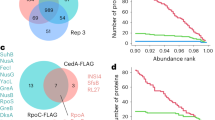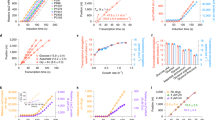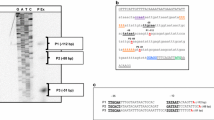Abstract
Translation elongation factor P, expressed by the efp gene, is a conserved protein closely related to bacterial virulence and environmental stress regulation responses, however, little is known about the efp gene expression regulations. Here, the strain of Staphylococcus aureus subsp. aureus NCTC 8325 was taken as the research object and cultured under different conditions, including different culture temperatures, pH, and antibiotics, to study the expression of the efp gene in S. aureus by qRT-PCR, the results showed that the expression of the efp gene is upregulated under high temperature (40 °C), acidic (pH 5.4) or alkaline (pH 9.4) culture conditions, but upregulated early and downregulated later under the conditions of 0.5 MIC antibiotics (chloramphenicol at the final concentration of 2 μg/mL and vancomycin at the final concentration of 0.25 μg/mL), indicating that the efp promoter in S. aureus is inducible. The efp promoter sequence and structure in S. aureus were predicted by bioinformatics methods, and the predicted promoter was validated by constructing a promoter-probe vector and a series of promoter mutants, the results showed that the efp promoter sequence in S. aureus, named Pro, located in 1,548,179–1,548,250 of the S. aureus genome (NC_007795.1), and the sequence of − 10 element is CCTTATAGT, − 35 element is TTTACT. The results above could lay a foundation for screening transcription factors involved in the expression of the efp gene and then exploring the transcriptional regulation mechanism of EF-P in S. aureus.






Similar content being viewed by others
Data availability
The original contributions presented in the study are included in the manuscript/Supplementary material, further inquiries can be directed to the corresponding author.
References
Balibar CJ, Iwanowicz D, Dean CR (2013) Elongation Factor P is dispensable in Escherichia coli and Pseudomonas aeruginosa. Curr Microbiol 67:293–299. https://doi.org/10.1007/s00284-013-0363-0
Berscheid A, Sass P, Eber-Lassalle K, Cheung AL, Bierbaum G (2012) Revisiting the genomes of the Staphylococcus aureus strains NCTC 8325 and RN4220. Int J Med Microbiol 302(2):84–87. https://doi.org/10.1016/j.ijmm.2012.01.002
Chalfie M, Tu Y, Euskirchen G, Ward WW, Prasher DC (1994) Green fluorescent protein as a marker for gene expression. Science 263(5148):802–805. https://doi.org/10.1126/science.8303295
Choi S, Choe J (2011) Crystal structure of elongation factor P from Pseudomonas aeruginosa at 1.75 Å resolution. Proteins Struct Funct Genet 79(5):1688–1693. https://doi.org/10.1002/prot.22992
Doerfel LK, Rodnina MV (2013) Elongation factor P: function and effects on bacterial fitness. Biopolymers 99(11):837–845. https://doi.org/10.1002/bip.22341
Doerfel LK, Wohlgemuth I, Kothe C, Peske F, Urlaub H, Rodnina MV (2013) EF-P is essential for rapid synthesis of proteins containing consecutive proline residues. Science 339(6115):85–88. https://doi.org/10.1126/science.1229017
Eisenreich W, Rudel T, Heesemann J, Goebel W (2022) Link between antibiotic persistence and antibiotic resistance in bacterial pathogens. Front Cell Infect Mi 12:900848. https://doi.org/10.3389/fcimb.2022.900848
Feaga HA, Hong H, Prince CR, Rankin A, Buskirk AR, Dworkin J (2023) Elongation factor P is important for sporulation initiation. J Bacteriol. https://doi.org/10.1128/jb.00370-22
Fisher RA, Gollan B, Helaine S (2017) Persistent bacterial infections and persister cells. Limnol Oceanogr Method 15(8):453–464. https://doi.org/10.1038/nrmicro.2017.42
Fujino Y, Goda S, Suematsu Y, Doi K (2020) Development of a new gene expression vector for Thermus thermophilus using a silica-inducible promoter. Microb Cell Fact 19(1):126. https://doi.org/10.1186/s12934-020-01385-2
Glick BR, Ganoza MC (1975) Identification of a soluble protein that stimulates peptide bond synthesis. Proc Natl Acad Sci USA 72(11):4257–4260. https://doi.org/10.1073/pnas.72.11.4257
Golubev A, Validov SZ, Usachev KS, Yusupov MM (2019) Elongation factor P: new mechanisms of function and evolutionary diversity of translation regulation. Mol Biol 53(4):501–512. https://doi.org/10.1134/S0026898419040037
Golubev A, Fatkhullin B, Gabdulkhakov A, Bikmullin A, Nurullina L, Garaeva N, Islamov D, Klochkova E, Klochkov V, Aganov A, Khusainov I, Validov S, Yusupova G, Yusupov M, Usachev K (2020a) NMR and crystallographic structural studies of the Elongation factor P from Staphylococcus aureus. Eur Biophys J Biophys 49(3–4):223–230. https://doi.org/10.1007/s00249-020-01428-x
Golubev A, Negroni L, Krasnovid F, Validov S, Yusupova G, Yusupov M, Usachev K (2020b) Posttranslational modification of elongation factor P from Staphylococcus aureus. FEBS Open Bio 10(7):1342–1347. https://doi.org/10.1002/2211-5463.12901
Hanawa-Suetsugu K, Sekine S, Sakai H, Hori-Takemoto C, Terada T, Unzai S, Tame JR, Kuramitsu S, Shirouzu M, Yokoyama S (2004) Crystal structure of elongation factor P from Thermus thermophilus HB8. Proc Natl Acad Sci USA 101(26):9595–9600. https://doi.org/10.1073/pnas.0308667101
Harley CB, Reynolds RP (1987) Analysis of E. coli promoter sequences. Nucleic Acids Res 15(5):2343–2361. https://doi.org/10.1093/nar/15.5.2343
Hummels KR, Kearns DB (2020) Translation elongation factor P (EF-P). FEMS Microbiol Rev 44(2):208–218. https://doi.org/10.1093/femsre/fuaa003
Kagiya G, Ogawa R, Hatashita M, Takagi K, Kodaki T, Hiroishi S, Yamamoto K (2005) Generation of a strong promoter for Escherichia coli from eukaryotic genome DNA. J Biotechnol 115(3):239–248. https://doi.org/10.1016/j.jbiotec.2004.08.015
Katz A, Solden L, Zou SB, Navarre WW, Ibba M (2014) Molecular evolution of protein-RNA mimicry as a mechanism for translational control. Nucleic Acids Res 42(5):3261–3271. https://doi.org/10.1093/nar/gkt1296
Kyrpides NC, Woese CR (1998) Universally conserved translation initiation factors. Proc Natl Acad Sci USA 95(1):224–228. https://doi.org/10.1073/pnas.95.1.224
Li H, Ding Y, Zhao J, Ge R, Qiu B, Yang X, Yao L, Liu K, Wang C, Du B (2019) Identification of a native promoter PLH-77 for gene expression in Paenibacillus polymyxa. J Biotechnol 295:19–27. https://doi.org/10.1016/j.jbiotec.2019.02.002
Neve RL, West RW, Rodriguez RL (1979) Eukaryotic DNA fragments which act as promoters for a plasmid gene. Nature 277(5694):324–325. https://doi.org/10.1038/277324a0
O’Neill MC (1989) Escherichia coli promoters. I. Consensus as it relates to spacing class, specificity, repeat substructure, and three-dimensional organization. J Biol Chem 264(10):5522–5530. https://doi.org/10.1016/S0021-9258(18)83576-1
Rajkovic A, Hummels KR, Witzky A, Erickson S, Gafken PR, Whitelegge JP, Faull KF, Kearns DB, Ibba M (2016) Translation control of swarming proficiency in Bacillus subtilis by 5-amino-pentanolylated elongation factor P. J Biol Chem 291(21):10976–10985. https://doi.org/10.1074/jbc.M115.712091
Shi L, Li K, Zhang H, Xu L, Lin J, Wei D (2014) Identification of a novel promoter gHp0169 for gene expression in Gluconobacter oxydans. J Biotechnol 175:69–74. https://doi.org/10.1016/j.jbiotec.2014.01.035
Tollerson R, Witzky A, Ibba M (2018) Elongation factor P is required to maintain proteome homeostasis at high growth rate. Proc Natl Acad Sci USA 115(43):11072–11077. https://doi.org/10.1073/pnas.1812025115
Tong SYC, Davis JS, Eichenberger E, Holland TL, Fowler VG Jr (2015) Staphylococcus aureus infections: epidemiology, pathophysiology, clinical manifestations, and management. Clin Microbiol Rev 28(3):603–661. https://doi.org/10.1128/CMR.00134-14
Turner NA, Sharma-Kuinkel BK, Maskarinec SA, Eichenberger EM, Shah PP, Carugati M, Holland TL, Fowler VG Jr (2019) Methicillin-resistant Staphylococcus aureus: an overview of basic and clinical research. Nat Rev Microbiol 17(4):203–218. https://doi.org/10.1038/s41579-018-0147-4
Ude S, Lassak J, Starosta AL, Kraxenberger T, Wilson DN, Jung K (2013) Translation elongation factor EF-P alleviates ribosome stalling at polyproline stretches. Science 339(6115):82–85. https://doi.org/10.1126/science.1228985
Valdivia RH, Hromockyj AE, Monack D, Ramakrishnan L, Falkow S (1996) Applications for green fluorescent protein (GFP) in the study of host-pathogen interactions. Gene 173(1):47–52. https://doi.org/10.1016/0378-1119(95)00706-7
West RW, Rodriguez RL (1980) Construction and characterization of E. coli promoter-probe plasmid vectors. II. RNA polymerase binding studies on antibiotic-resistance promoters. Gene 9(3–4):175–193. https://doi.org/10.1016/0378-1119(90)90321-h
West RW, Neve RL, Rodriguez RL (1979) Construction and characterization of E. coli promoter-probe plasmid vectors. I. Cloning of promoter-containing DNA fragments. Gene 7(3):271–288. https://doi.org/10.1016/0378-1119(79)90048-9
Wright GD (2005) Bacterial resistance to antibiotics: enzymatic degradation and modification. Adv Drug Deliver Rev 57(10):1451–1470. https://doi.org/10.1016/j.addr.2005.04.002
Zou SB, Roy H, Ibba M, Navarre WW (2011) Elongation factor P mediates a novel post-transcriptional regulatory pathway critical for bacterial virulence. Virulence 2(2):147–151. https://doi.org/10.4161/viru.2.2.15039
Zou SB, Hersch SJ, Roy H, Wiggers JB, Leung AS, Buranyi S, Xie JL, Dare K, Ibba M, Navarre WW (2012) Loss of elongation factor P disrupts bacterial outer membrane integrity. J Bacteriol 194(2):413–425. https://doi.org/10.1128/JB.05864-11
Funding
This research was supported financially by the National Natural Science Foundation of China (Grants 31960015) and the Natural Science Foundation of Jiangxi Province, China (Grants 20192BAB204001).
Author information
Authors and Affiliations
Contributions
All authors contributed to the study conception and design. Material preparation, data collection, and analysis were performed by Xingxing Zheng, Xiuhui Sun, Weiwei Xiang, Haiyan Ni, and Long Zou. Zhong-er Long, Xingxing Zheng, and Xiuhui Sun wrote the manuscript. All authors read and approved the final manuscript.
Corresponding author
Ethics declarations
Competing interests
The authors declare no competing interests.
Conflict of interest
The authors declare that they have no conflict of interest.
Ethical statement
This article does not contain any studies with human participants and/or animals performed by any authors. Formal consent is not required in this study.
Additional information
Publisher's Note
Springer Nature remains neutral with regard to jurisdictional claims in published maps and institutional affiliations.
Supplementary Information
Below is the link to the electronic supplementary material.
Rights and permissions
Springer Nature or its licensor (e.g. a society or other partner) holds exclusive rights to this article under a publishing agreement with the author(s) or other rightsholder(s); author self-archiving of the accepted manuscript version of this article is solely governed by the terms of such publishing agreement and applicable law.
About this article
Cite this article
Zheng, X., Sun, X., Xiang, W. et al. Expression of Staphylococcus aureus translation elongation factor P is regulated by a stress-inducible promotor. Antonie van Leeuwenhoek 117, 54 (2024). https://doi.org/10.1007/s10482-024-01954-0
Received:
Accepted:
Published:
DOI: https://doi.org/10.1007/s10482-024-01954-0




